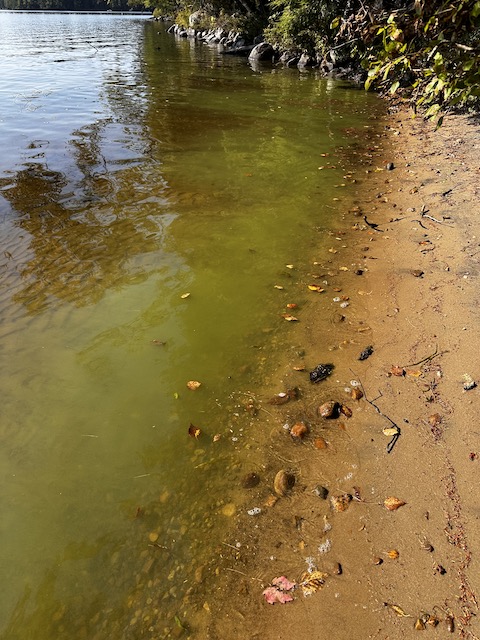LOOKING AT THE MIRROR: Be on the lookout for harmful algal blooms on Mirror Lake
SEP 21, 2023
SANDY EDGERTON BISSELL
Mirror Lake Watershed Association

Blue-green harmful algal blooms, which are often green, may look like parallel streaks on the water surface. This is the HAB seen on Mirror Lake in November 2022. (Provided photo)
All who appreciate Mirror Lake need to be on the lookout now for harmful algal blooms (HABs). The lake’s two confirmed blooms in the last three years occurred in October and November. Beware those warm days with a light breeze and sunshine. This summer’s high temperatures and heavy rainfall exacerbate the likelihood of HABs, and when they develop, it is important to stay out of the water and not allow children or dogs to play in beach debris.
HABs have recently been identified on several nearby bodies of water: Upper Saranac Lake, Blue Mountain Lake, Barnum Pond, Bubb Lake, St. Regis Lake and Little Colby. They can create serious hazards for those exposed to them.
Between July and November, most commonly in September and October, Adirondack waters may develop harmful algal blooms. The first positively identified HAB in Mirror Lake was reported in November of 2020 near the public beach. Last year, one was spotted on Halloween at the boat rental area on the northern end of Main Street. But it “was present across much of the lake,” according to Brendan Wiltse, chief senior research scientist for the Paul Smith’s College Adirondack Watershed Institute. He explains that the toxicity of a bloom may vary from one time of day to another and even from one part of the bloom to another part so best practice is to avoid bodies of waters where blooms have been identified for the following few days.
“HABs: Know it, Avoid it, Report it!” This is the state Department of Environmental Conservation’s catch phrase. Everyone who enjoys Mirror Lake, even those just walking around it, can help by getting acquainted with the look of HABs and becoming vigilant observers of the water.
Check out images on the DEC and AWI websites because HABs take on many different forms. The one in Mirror Lake last fall looked like pollen suspended in the water. Often, according to the DEC, HABs will look like scum or a floating mat and can have a wide range of colors from green, blue-green, yellow, brown, or red. The AWI website says the HABs often look like “clumps of green dots on the lake surface or green surface scum with parallel lines or streaks …” Some look like “splled paint or pea soup.”
If a harmful algal bloom was seen on Mirror Lake, people would see this sign along the shore with a warning.
HABs are difficult to identify and need to be tested in a lab to be confirmed. Ideally, a close-up digital photo as well as a wider angle shot from a smart phone are helpful for identification because they can easily be shared and will identify the location of the potential HAB. Alternatively, a photo, a description, and a location based on landmarks may be submitted.
In July, the Mirror Lake Watershed Association delivered eight new signs to the town of North Elba to be placed around Mirror Lake in the event we experience another HAB. Last year’s warnings were hurriedly produced printouts on 8.5 x 11 inch copy paper, too small for most people to notice. The new signs are bright yellow, red, and black warning signs (see photo) and were printed on 16 x 20 inch aluminum in hopes they would be more effective at alerting the public.
The town has mounted the signs on stands and will place them strategically on public property when necessary. People who are used to enjoying access to the lake from private property, as well as the general population, should be on the lookout for these signs at the public beach, Mid’s Park, Brewster Park and the boat carry across from the state boat launch.
Because it is important to know as soon as possible when a HAB is suspected, the MLWA has devised a response plan. First off, go to the DEC website and complete a Suspicious Algal Bloom Report. Then AWI should be notified so they, too, can sample and verify. They coordinate with the DEC, but may be able to get to the lake faster and get the sample tested sooner which could save valuable time. Concurrently, the town, village, and ROOST will be alerted so the signs can go up and the hotels can notify their visitors.
As a precaution, everyone should stay out of the water and keep their dogs out as well. Dogs can die from exposure to a HAB because of their level of exposure; they often drink as they swim and then clean themselves afterward by licking their fur. Children are especially vulnerable which is why they should not be allowed to play in the sand, but adults can experience serious illnesses, too.
To learn more about the MLWA’s volunteer efforts to protect Mirror Lake and Mill Pond, go to mirrorlake.net, follow us on Instagram or join us for our monthly meetings upstairs at the Mirror Lake Beach House on the second Monday of the month at 5 p.m.
(Sandy Edgerton Bissell is on the board of the Mirror Lake Watershed Association in Lake Placid.)
